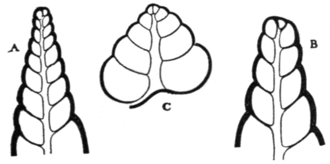Ailanthus silk-worm moth[1] I will pass by without discussion, since I believe he is soon to publish further observations on the same subject.
Weldon's work on natural selection was not limited to Crustacea, but extended to the mollusca as well.
The shells of certain snails, such as Clausilia and Helix, is essentially a tube increasing in size as the animal grows older and wound in a spiral, or more properly a helix, around a central axis with the successive coils in contact. If one of these shells be cut longitudinally, the central cone, or columella, as it is technically called, will be laid open and will appear as a narrow conical tube extending the whole length of the shell, while the tube which contained the animal will be cut across twice in each complete revolution and will appear in cross section.
This point is made quite clear by an examination of the three diagrams (Fig. 4).

By deft manipulation such sections can be prepared. A shell may be ground upon a soft stone until a plane which extends almost exactly through the central columella is exposed.[2] From such a preparation it is quite possible to make the measurements which determine the pitch and several other characteristics of the spiral.
The shell of these snails is a permanent structure. In the adult the whorls first laid down by the young animals can be measured. Now it is clear that one can compare the properties of the portions of the spiral already laid down in the shell of a young snail with the same portions in the shell of an adult. In snails, as in other animals, not all individuals survive to adult life. The problem is to find out whether the properties of the first-formed portions of the spirals of the shells of
- ↑ Crampton, A. E., "Experimental and Statistical Studies upon Lepidoptera. I. Variation and Elimination in Phylosamia cynthia," Biometrika, Vol. III., pp. 113-130, 1904.
- ↑ To be sure, the work is exceedingly tedious and many shells are accidentally spoiled, but four or five may be prepared in a day's work and in the course of time a number sufficient for statistical work may be secured.
